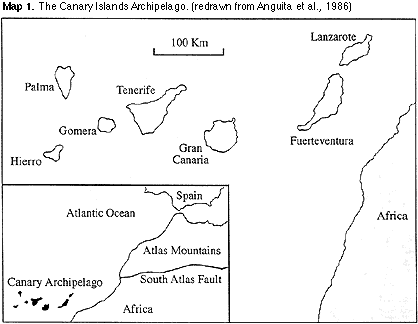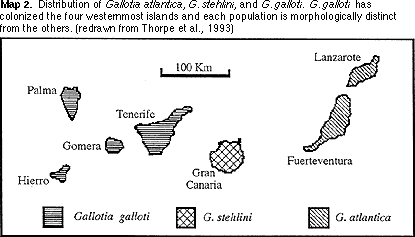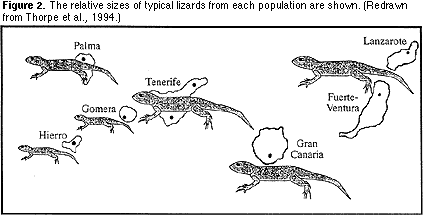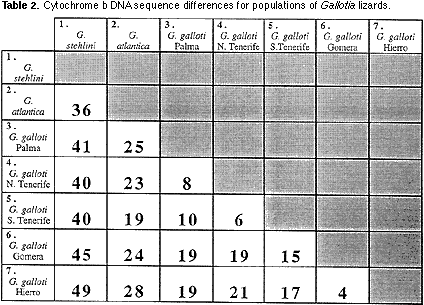ISLAND BIOGEOGRAPHY AND EVOLUTION: SOLVING A PHYLOGENETIC PUZZLE USING MOLECULAR GENETICSR.P. FILSONPREFACEISLAND BIOGEOGRAPHY and Evolution is an activity about the evolution of three species of lizards on the Canary Islands. It is designed for high school biology students. Its purpose is to demonstrate to students that evolutionary problems are complex, and solutions may involve data from various disciplines of science. First, students must arrive at different phylogenetic solutions using only geographical and geological data. Then, students compare the morphology of the species involved, arriving at a more traditional solution to phylogeny. Finally, students deduce a phylogeny based on genetic distance using DNA sequences from cutting edge biotechnology. The strength of the activity is its depth and interdisciplinary approach. This activity reinforces the interdisciplinary nature of modern science. Students utilize real data from real scientists. Students apply the principles of evolution in their reasoning to make use of this data from geology and biological science. This activity originated at Princeton University in the summer of 1995 while I was a participant in the Woodrow Wilson National Foundation Institute on Biology. Though now modified, it was written as part of a biology module on evolution called “Evolution: A Context for Biology.” My original intent was to write a similar activity on Galapagos Finches, but that proved to be too complex and DNA mapping data had yet to be published. For purposes of this publication, I have placed the student activity in the beginning followed by teacher information and my discussion of possible solutions.
ISLAND BIOGEOGRAPHY AND EVOLUTION: SOLVING A PHYLOGENETIC PUZZLE WITH MOLECULAR GENETICSINTRODUCTIONEver since Charles Darwin formulated his hypothesis on how the finches of the Galapagos Islands evolved into 13 species, islands have been a prime target for the study of evolution. By their very nature, islands are isolated and are essentially a living laboratory of evolution. In this investigation, you should be familiar with the terms speciation, geographic isolation, gene flow, gene pool, and reproductive isolation. You will work with real data from real populations. The data will include observations of lizard morphology (body form), geological age estimates of various islands in the Canary Island Archipelago, geographic distances, and genetic distances based on nucleotide base differences in DNA between different populations of lizards.  Return to top Return to top
The development of ecosystems on volcanic islands is somewhat unpredictable. However, ecological succession does occur first with pioneer organisms that gradually alter the environment until a stable climax community is established. What is unpredictable is what plant and animal species will colonize these new environments. Much of this is left to climate, proximity to other land masses, and of course, chance. This investigation deals with three species of lizards of the genus Gallotia, and within one of these species, Gallotia galloti, four separate island populations. The arrival of the Gallotia lizards was probably by rafting (See Map 1). Rafts of natural vegetation are often washed out to sea when high river levels cause river banks to collapse, carrying away both plants and clinging animals. Oceanic currents in this region vary with the seasons. Colonization by airborne organisms, such as insects and birds, usually occurs during storms. In any case, there are some general principles of island colonization:
1) The closer the island to another land mass, the higher the probability of colonization.

Problem — Evolution biologists have been faced with an interesting problem. What is the phylogenetic history of the three species and seven populations of Gallotia lizards on the Canary Islands? Does the presence of four morphologically different populations of G. galloti on the four westernmost islands (Map 2) imply continuing evolution? In this investigation, you will use data from geography, geological history, morphology (body size), and molecular genetics to develop answers to these questions.
PART I: PHYLOGENY BASED ON GEOGRAPHIC DISTANCEProcedure — Using Map 1 (download a pdf version), measure the distance in kilometers of each island to the mainland (Africa). List these distances on a separate page. Include the following islands: Lanzarote, Fuerteventura, Gran Canaria, Tenerife, Gomera, Palma, and Hierro. Return to top Return to top
1) Which island is most likely to have been colonized first and which last? Tell why you think so. 2) Using Map 2 (download a pdf version—includes Table 1 below) and your geographic reasoning, draw on a separate page a hypothetical phylogenetic (family) tree of the three species and the three additional populations of G. galloti. Your teacher will demonstrate how to draw a phylogenetic tree. Label your end branches with the following population names:

PART II: PHYLOGENY BASED ON GEOLOGICAL HISTORYCheck your hypothetical phylogenetic tree against the geological data in Table 1 (download a pdf version—includes Map 2 above). The maximum age of each island was estimated by sampling volcanic rocks found on all islands. The ratio of radioactive potassium to its breakdown product, argon, was used to estimate the age of the rocks.
1) Explain how the data in Table 1 (above) support your phylogeny diagram? Or what changes
should you make and why?
PART III: PHYLOGENY BASED ON MORPHOLOGYStudy the drawings from each lizard population in Figure 2 below (download a pdf version). Compare and contrast their body size with the distribution on Map 2. To be sure differences were genetic, not environmental, researchers collected individuals from all island populations and bred and raised them in captivity. Their offspring still displayed differences according to their parental characteristics. Draw a new phylogeny chart based on morphological similarities and differences.Compare your two phylogeny charts. Describe how they are different.

PART IV: PHYLOGENY BASED ON MOLECULAR GENETICSRecent studies by R.S. Thorpe (1993, 1994) have attempted to support various phylogenetic hypotheses by comparing genetic differences among the populations of the Gallotia lizards on the Canary Islands. The gene for cytochrome b, which is coded by DNA found in every cell’s mitochondria, was used in this study along with DNA from other genes. Cytochrome b is an important substance for cell metabolism and has probably been around since the first prokaryotes. Changes in its nucleotide base sequence (A, T, C, and G) that do not disrupt the gene’s function provide us with a kind of evolutionary clock. The rate of mutational changes due to pairing errors is relatively constant. The chances for such mutations are the same for any of these bases. This means that the more time, the more changes. When two populations are isolated and gene flow between them is restricted, the mutational differences accumulate over time. The longer the isolation the greater the difference.
Thorpe and his colleagues used restriction enzymes to cut the DNA, and gel electrophoresis to
separate the fragments. Radioisotope tagging eventually led to the sequencing of the samples
of DNA for each of the seven populations. Thorpe tested two populations on Tenerife to see
if ecological differences were part of the story. He felt that because Tenerife is moist and lush
in the north while arid and barren in the south, populations on that island might have some
genetic differences. Also, he wondered if Tenerife was supplying colonizing lizards from two
different directions. The results for Thorpe’s tests appear on the last two pages of this
investigation. Your task is to count the differences between all pairings of the seven populations and use that data to construct a final phylogenetic tree based on genetic similarities and differences. Procedure — There are 21 different pair combinations possible using seven populations. You should work in a team of four. Each person will be responsible for counting all of the base differences for five of the 21 pairs (see chart below). The pairings are listed on Table 2 (download a pdf version). Note that the first pairing has been counted for you. Record your results in Table 2. When all teams are done, the data will be checked for agreement. The easiest way to make accurate counts is to cut the paper into four strips and tape them end to end in the correct order, A to D. You will then compare pairs of strips side by side to count the differences. There are 21 possible pairings, each team member selects five pairings other than 1/2.
INTERPRETATIONS AND CONCLUSIONSUse the data from Table 2 to guide you in redrawing your phylogenetic tree of the Gallotia lizards of the Canary Islands using both geographic and genetic information. Consider the two populations on Tenerife as a single population so that the phylogenetic tree contains six populations.
Low numbers express more genetic similarity and imply more
recent common ancestry. Pairs with high numbers are said to have greater genetic
distance between them. In other words, large numbers imply they are less genetically alike, have more distant ancestry, and have
been separated longer. On a phylogenetic tree, early ancestry is expressed by low branches
while more recently evolved are on the higher branches. Branches that are far apart imply greater genetic distance.

1) In Table 2, large numbers imply that pairs of populations are less related. Why is this? 2) Among the six populations, there are three species. How many base pair differences is the minimum to separate any two species of these lizards? (Remember, don’t confuse populations with species.) Give an example to support your answer. 3) Which two populations are most closely related? Justify your answer. 4) Why should you expect the populations S. Tenerife (ST) and N. Tenerife (NT) to have fewer differences than other pairings? 5) Which population is least related to the rest? Why do you say so? Refer to your last phylogeny chart using genetic similarities and differences found in Table 2. Compare it to the phylogeny chart you drew based on the geographic distances and geologic age of the islands. 6) What difference is there between the two phylogenies? 7) Which species, G. stehlini or G. atlantica, is the ancestor of the other? Explain your reasoning. 8) Predict what is likely to happen to the four populations of G. galloti on the four westernmost islands. State what conditions will support this prediction.
Table 3. Base-pair sequences from the mitochondrial genome for cytochrome b of Gallotia
species and populations. Island codes in parentheses are P = Palma, NT = north Tenerife, ST
= south Tenerife, G = gomera, and H = Hierro. Each sequence consists of four lines, e.g.,
1a+1b+1c+1d is the sequence for Gallotia stehlini. (Data from Thorpe et al., 1994).
Download a pdf version..
TEACHER INFORMATIONTarget Group: 9–12 college prep biology or honors biologyClass Time: Two days: first day, students can work independently, counting genetic differences can be assigned for homework; second day, student teams share data and the results should be discussed as a class. Can be extended over three days. Materials: Scissors and tape; an atlas would be a desirable option. All figures, tables, and maps (except Figure 1) are available as downloadable pdf files: Map 1 • Map 2 and Table 1 • Figure 2 • Table 2 (blank) • Phylogeny solutions • Table 2 (complete) Overview: This activity is a logic problem that is based on real organisms and real data. The problem is to develop phylogenies for seven related populations of lizards living on the Canary Islands. Three phylogenetic charts will be constructed, each using different forms of data: geography, geology, morphology, and molecular genetics. Prior Knowledge Needed: This activity would be best used near the end of an evolution unit. Knowledge of the DNA code is needed and a basic understanding of biotechnologies such as gel electrophoresis, and DNA fingerprinting would be desirable. Students must know the difference between a population and a species. Students should be aware of the conditions of speciation including isolation, genetic divergence, and reproductive isolation. Teacher Instructions: You may give this assignment out in pieces so as not to give students too much information on determining phylogenies. Students should not be given Figure 2 and Map 2 until completing Part I. This could be done at home as homework. Part IV is the most difficult and most logistically demanding part of this investigation. Students will be comparing the DNA sequences for cytochrome b from seven populations. Only the first population has the complete sequence. All others listed below it have listed only what is different. However, each population must be compared with each other population. This makes for 21 pairings, a formidable task even for the teacher. The strategy is to share the work. All pairing combinations are given in the student instructions. Basically, students work in teams of four with each student counting differences for five pairings. Teams compare results to check for accuracy. Students need not cut the DNA sequences into seven separate strips. Creating one long strip from the four sections by taping end to end works well for students comparing the seven sequences.
The final activity will be to use the results from the pairings to compare the differences, and
use this information to develop a final phylogeny chart. The
solutions are provided below. The diagrams appear to be cladograms, but technically, they are not.
Their similarity to cladograms is more related to their ease in drawing. The basic scheme is that
low numbers of base pair differences
imply closer evolutionary relationships. The phylogeny charts are intended to stimulate
student thinking about the problems of understanding past and future evolution. There are
many variations to phylogenies students can come up with, some better than others. The
criteria should really be: can the solution be logically explained and justified. Only the last
phylogeny based on both molecular genetics and biogeography has fewer variations and needs some serious
discussion to close the subject. Finally, most questions on this assignment cannot be
answered without student explanation. You should emphasize that answers may vary, but
logic is required for all solutions. The information that follows is intended as a guide to solutions to the phylogenies based on different types of data. These are my interpretations and are by no means definitive.

 Return to top Return to top
Refer to your last phylogeny chart using genetic similarities and differences found in Table 2. Compare it to the phylogeny chart you drew based on the geographic distances and geologic age of the islands.
REFERENCESAnguita, F., and F. Hernan. 1986. Geochronology of some Canarian dike swarms: contribution to the volcano-tectonic evolution of the archipelago. Journal of Volcanology and Geothermal Research 30:155–162.Thorpe, R.S., and R.P. Brown. 1989. Microgeographic variation of the colour pattern of Canary Island lizard, Gallotia galloti within the island of Tenerife: distribution, pattern and hypothesis. Biological Journal of the Linnean Society 38:303–322. Thorpe, R.S., D.P. McGregor, and A.M. Cumming. 1993. Population evolution of Canary Island lizards, Gallotia galloti: four base endonuclease restriction of fragment length polymorphisms of mitochondrial DNA. Biological Journal of the Linnean Society 49:219– 227. Thorpe, R.S., R.P. Brown, M. Day, A. Malhotra, D.P. McGregor, and W. Wuster. 1994. Testing ecological and phylogenetic hypotheses in microevolutionary studies. Pp. 189–206 in E.P. Eggleton and R. Vane-Wright (eds.), Phylogenetics and Ecology. Academic Press, London.
Thorpe, R.S., D.P. McGregor, A.M. Cumming, and W.C. Jordan. 1994. DNA evolution and
colonization sequence of island lizards in relation to geological history. Evolution 48:230–240.
ACKNOWLEDGMENTSFigure 1 reprinted from the Biological Journal of the Linnean Society 38:303–322: R.S. Thorpe, and R.P. Brown. 1989. Microgeographic variation of the colour pattern of Canary Island lizard, Gallotia galloti within the island of Tenerife: distribution, pattern and hypothesis. Figure 5A, p. 312. With the kind permission of Academic Press, London.Map 1 redrawn from the Journal of Volcanology and Geothermal Research 30:155–162: F. Anguita and F. Hernan. 1986. Geochronology of some Canarian dike swarms: contribution to the volcano- tectonic evolution of the archipelago. With the kind permission of Elsevier Science-NL, Sara Burgerhartstraat 25, 1055 KV Amsterdam, The Netherlands. Map 2 redrawn from the Biological Journal of the Linnean Society 49:219–227: R.S. Thorpe , D.P. McGregor, and A.M. Cumming. 1993. Population evolution of Canary Island lizards, Gallotia galloti: four base endonuclease restriction of fragment length polymorphisms of mitochondrial DNA. With the kind permission of Academic Press, London. Figure 2 redrawn from Phylogenetics and ecology, E.P. Eggleton and R. Vane-Wright (eds.), 1994: Pp. 189–206. R.S. Thorpe, R.P. Brown, M. Day, A. Malhotra, D.P. McGregor, and W. Wuster. Testing ecological and phylogenetic hypotheses in microevolutionary studies. With the kind permission of Academic Press, London.
|

 At left is one possible solution (download a
At left is one possible solution (download a  At left is a possible solution using island distribution and morphology. In using body
size, one is tempted to guess that medium lizards of Palma could have been the immediate
ancestors to Gomera and the small lizards of Gomera are ancestors to the small lizards of
Hierro. This could contradict the argument based on distance. Again, there is no one perfect
answer. Ecologists and geneticists have debated several hypotheses for years. Numbers imply
chronology.
At left is a possible solution using island distribution and morphology. In using body
size, one is tempted to guess that medium lizards of Palma could have been the immediate
ancestors to Gomera and the small lizards of Gomera are ancestors to the small lizards of
Hierro. This could contradict the argument based on distance. Again, there is no one perfect
answer. Ecologists and geneticists have debated several hypotheses for years. Numbers imply
chronology. The solution at left uses DNA evidence from
The solution at left uses DNA evidence from